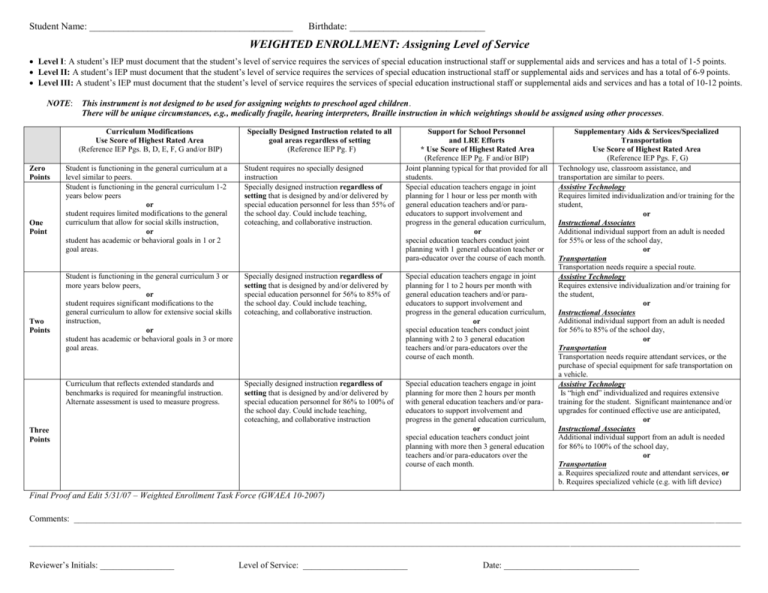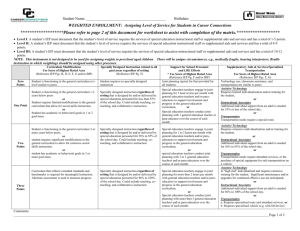serviceslevelmatrix
advertisement

Student Name: __________________________________________ Birthdate: ____________________________ WEIGHTED ENROLLMENT: Assigning Level of Service Level I: A student’s IEP must document that the student’s level of service requires the services of special education instructional staff or supplemental aids and services and has a total of 1-5 points. Level II: A student’s IEP must document that the student’s level of service requires the services of special education instructional staff or supplemental aids and services and has a total of 6-9 points. Level III: A student’s IEP must document that the student’s level of service requires the services of special education instructional staff or supplemental aids and services and has a total of 10-12 points. NOTE: This instrument is not designed to be used for assigning weights to preschool aged children. There will be unique circumstances, e.g., medically fragile, hearing interpreters, Braille instruction in which weightings should be assigned using other processes. Curriculum Modifications Use Score of Highest Rated Area (Reference IEP Pgs. B, D, E, F, G and/or BIP) Zero Points One Point Two Points Specially Designed Instruction related to all goal areas regardless of setting (Reference IEP Pg. F) Support for School Personnel and LRE Efforts * Use Score of Highest Rated Area (Reference IEP Pg. F and/or BIP) Joint planning typical for that provided for all students. Special education teachers engage in joint planning for 1 hour or less per month with general education teachers and/or paraeducators to support involvement and progress in the general education curriculum, or special education teachers conduct joint planning with 1 general education teacher or para-educator over the course of each month. Student is functioning in the general curriculum at a level similar to peers. Student is functioning in the general curriculum 1-2 years below peers or student requires limited modifications to the general curriculum that allow for social skills instruction, or student has academic or behavioral goals in 1 or 2 goal areas. Student requires no specially designed instruction Specially designed instruction regardless of setting that is designed by and/or delivered by special education personnel for less than 55% of the school day. Could include teaching, coteaching, and collaborative instruction. Student is functioning in the general curriculum 3 or more years below peers, or student requires significant modifications to the general curriculum to allow for extensive social skills instruction, or student has academic or behavioral goals in 3 or more goal areas. Specially designed instruction regardless of setting that is designed by and/or delivered by special education personnel for 56% to 85% of the school day. Could include teaching, coteaching, and collaborative instruction. Special education teachers engage in joint planning for 1 to 2 hours per month with general education teachers and/or paraeducators to support involvement and progress in the general education curriculum, or special education teachers conduct joint planning with 2 to 3 general education teachers and/or para-educators over the course of each month. Curriculum that reflects extended standards and benchmarks is required for meaningful instruction. Alternate assessment is used to measure progress. Specially designed instruction regardless of setting that is designed by and/or delivered by special education personnel for 86% to 100% of the school day. Could include teaching, coteaching, and collaborative instruction Special education teachers engage in joint planning for more then 2 hours per month with general education teachers and/or paraeducators to support involvement and progress in the general education curriculum, or special education teachers conduct joint planning with more then 3 general education teachers and/or para-educators over the course of each month. Three Points Supplementary Aids & Services/Specialized Transportation Use Score of Highest Rated Area (Reference IEP Pgs. F, G) Technology use, classroom assistance, and transportation are similar to peers. Assistive Technology Requires limited individualization and/or training for the student, or Instructional Associates Additional individual support from an adult is needed for 55% or less of the school day, or Transportation Transportation needs require a special route. Assistive Technology Requires extensive individualization and/or training for the student, or Instructional Associates Additional individual support from an adult is needed for 56% to 85% of the school day, or Transportation Transportation needs require attendant services, or the purchase of special equipment for safe transportation on a vehicle. Assistive Technology Is “high end” individualized and requires extensive training for the student. Significant maintenance and/or upgrades for continued effective use are anticipated, or Instructional Associates Additional individual support from an adult is needed for 86% to 100% of the school day, or Transportation a. Requires specialized route and attendant services, or b. Requires specialized vehicle (e.g. with lift device) Final Proof and Edit 5/31/07 – Weighted Enrollment Task Force (GWAEA 10-2007) Comments: _________________________________________________________________________________________________________________________________________________________ ___________________________________________________________________________________________________________________________________________________________________ Reviewer’s Initials: _________________ Level of Service: ________________________ Date: _______________________________






